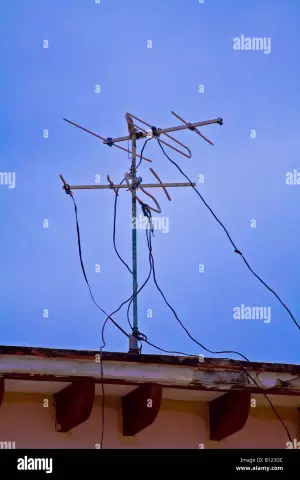Satellite television is becoming more and more popular. Conventional antennas cannot provide the desired image quality. But using a dish, everyone can watch TV channels in digital format. It costs a lot to buy the necessary equipment, so people sometimes look for a way to save money. For example, you can connect your TV to a satellite dish yourself. All modern TV satellites operate in the Ku-band (10, 7-12, 7 GHz).
Instructions
Step 1
First, you need to choose a location for installing the satellite dish. It is important that the view from the installation point to the satellite is open. All satellites are located in a southerly direction, from southwest to southeast. You can calculate the position of the cymbal using two formulas.
Formula for calculating the elevation angle:
F = arctan {[Cos (g2 - g1) x Cos (v) - 0.151] / sqrt (1 - Cos2 (g2 - g1) x Cos2 (v)]}
Formula for calculating azimuth:
φ = 180 ° + arctan {tan (g2 - g1) / sin (v)}
g1 is the longitude of the satellite, g2 is the longitude of the receiving location, v is the latitude of the receiving location.
The SATTV program will also help you in this matter.
Step 2
Make sure that there are no obstacles at all. Buildings, trees - all this will be a hindrance. But at the same time, the antenna should be located in an easily accessible place for you.
Assembly instructions should be included with the antenna. By following it exactly, you will be able to cope with the editing without any problems. The support must be fixed very rigidly. Be careful not to damage the parabolic mirror. Even small deviations lead to signal degradation.
Step 3
Now you can start connecting the equipment. In this case, you, being near the equipment, should also see the TV screen. You probably need an assistant. The converter is cabled to the receiver. A dark screen will appear. Now you need to set the frequency for the receiver using the on-screen menu.
Step 4
Next, you need to tighten the screws that adjust the movement of the antenna in the azimuth and elevation directions. But do this not all the way, but so that you can move the cymbal up and down and left and right, making some effort. In this case, the antenna must be stationary if not touched.
Step 5
Then you can start scanning the sky. After making sure that the signal is as clear as possible and the picture is good, fix the cymbal completely. Your satellite dish is connected to the TV and is ready to delight you with quality TV.






